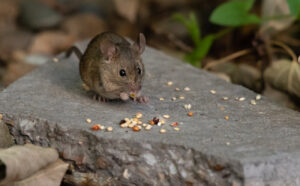All About The Brown Rat
Need Help? Call Us On 0161 776 9832 For Expert Pest Control Advice On How To Identify Pest Infestations And Help Solve Your Pest Problem.
Brown Rat

Brown rat eating scraps from the soil
The common brown rat ( Rattus norvegicus ) is seen in every corner of the globe and goes by many different regional names such as the Norwegian rat, sewer rat, or wharf rat. Common brown rats like many other disease ridden pests originated in Asia and began to spread to all continents except Antarctica via cargo vessels. This 25 cm long vermin is largely responsible for the displacement of the larger black rat, whose fleas were said to be responsible for the bubonic plague outbreak which killed nearly one-third of humans in Europe. Brown rats are the worlds most common rat, and cause outbreaks of disease and ruin food stores and infect water supply.
Habitat
The brown rat is versatile and can adapt to any environment. They usually make their lairs within 20 meters of a viable food source. Rats live in colonies or families of up to sixty rats and breeding is rapid with nearly 400 rats being born through interbreeding within a year from a single pair of rats. The rat damage caused by a single colony of rats is colossal. Brown rats prefer dark and damp conditions such as burrows along river banks, but man-made environments such as sewer systems, garages, and any structure where a food source is readily available to make excellent conditions for the brown rat’s domain. An attic will make a perfect location for a family of rats to begin breeding, with loft insulation and roofing felt for nesting material, cables to gnaw on, and a water supply from the tank that supplies the drinking water in the kitchen. Without rat control, the rat population of a loft space could explode within months.
Disease
Rats kill humans. Rats urine, faeces, and saliva carry Leptospirosis, and even when dried can be deadly to humans, especially to the elderly and young children. Dried urine on a tin of food can infect the contents when opened and is responsible for many human deaths annually. It is advisable for everyone to wipe the lids of cans prior to opening. Rattus norvegicus in the loft can present many disease problems with drinking water and bacteria from the mucous produced by rats. Rat removal procedures will eliminate the risk of diseases and ensure a more hygienic abode. Diseases such as Weil’s disease, cryptosporidiosis, and rat-bite fever are common diseases transmitted by roof rats, as are viral hemorrhagic fever, and Q fever, all of which are potentially dangerous to humans. Rat droppings per rat number between 40 and 50 every day, leaving a trail of bacteria producing spores.
Rat Damage
Rat infestations rapidly chew through residential and commercial telephone and electric cables, causing electricity cuts and fires adding to the fatality rate of homeowners and increased insurance premiums. Brown rats will strip the felt from the inside of a roof for the nest causing water to begin to seep through, damaging internal plaster and beams. Rats are a vermin whose prime objective is to eat and breed, causing chaos to food stores, killing household pets including cats and dogs with their mucous excretions. Rats present an abundance of opportunities for contagious viral infections, rat bites, and deadly diseases.
Professional rat removal companies can discreetly remove rats from any loft, basement, or building preventing any further rat damage. Rapid rat control procedures are required to keep the rat population down in any given area, reducing breeding habits and eliminating potential risks.
